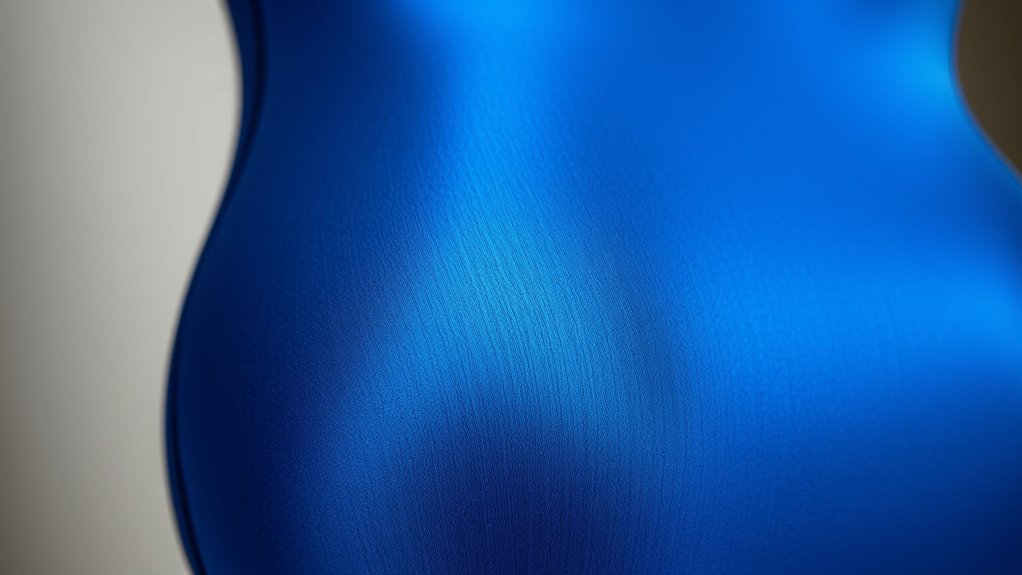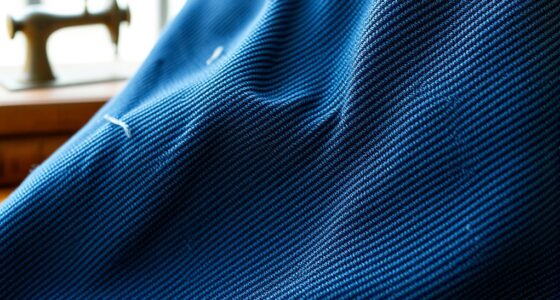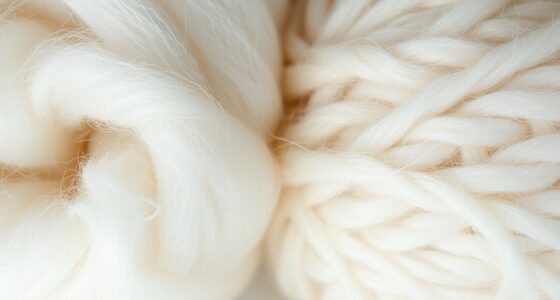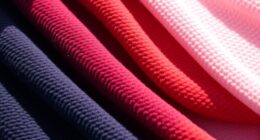Spandex, also known as elastane, is a stretch fiber that transforms your wardrobe by offering exceptional flexibility, shape retention, and comfort. It allows garments to stretch up to five times their original size, ensuring a perfect fit and freedom of movement. You’ll find it everywhere—from activewear and jeans to dresses—adding durability and a sleek look. To discover how spandex combines comfort with style and its versatile uses, keep exploring further.
Key Takeaways
- Spandex, also known as elastane, is a highly stretchable fiber that expands up to five times its original length.
- It is widely used in modern apparel like sportswear, yoga pants, and compression garments for flexibility and support.
- Spandex allows for sleek, form-fitting designs, enhancing fit, comfort, and shape retention in various clothing styles.
- The fiber’s durability ensures garments resist sagging and maintain elasticity after repeated washing and wear.
- Lightweight and breathable, spandex provides quick-drying properties, supporting active lifestyles and fashion versatility.
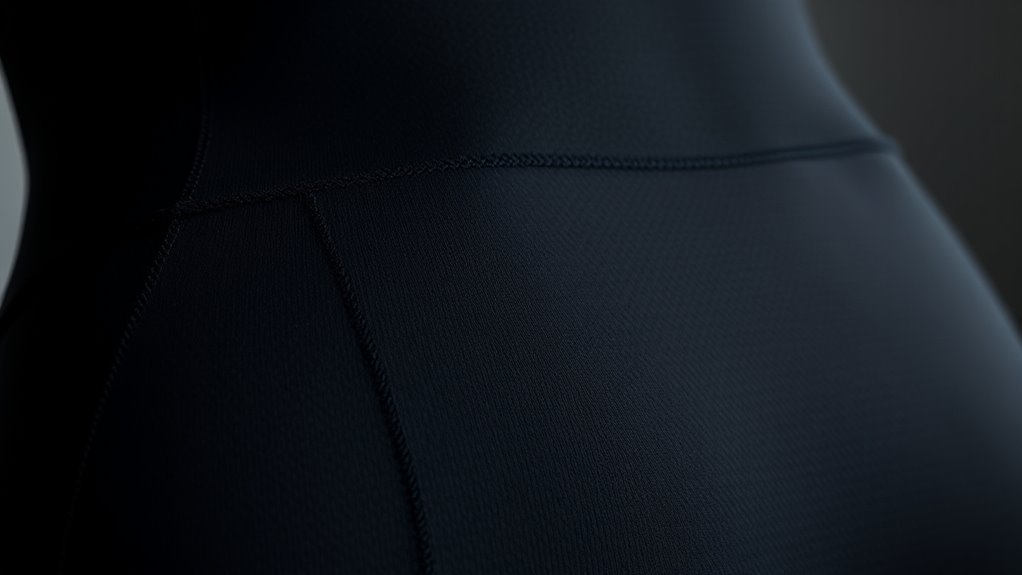
Have you ever wondered what makes athletic wear so comfortable and flexible? The secret lies in the fabric’s ability to stretch and move with you, and that’s where spandex, also known as elastane, comes into play. This revolutionary fiber has transformed modern apparel, especially athletic wear, by offering unparalleled stretchability and shape retention. When you slip into your workout gear or even everyday clothing made with spandex, you’re experiencing the benefits of a material engineered for performance and comfort. Its ability to stretch up to five times its original length ensures that your clothing moves seamlessly with your body, providing both support and freedom of movement. That’s why sportswear, yoga pants, and compression garments rely heavily on spandex to deliver optimal fit and flexibility.
Beyond the gym, spandex’s influence extends into the broader domain of fashion versatility. Designers love incorporating this fiber into various garments because it allows for sleek, form-fitting styles that maintain their shape over time. Whether it’s a fitted dress, a pair of skinny jeans, or a stylish activewear ensemble, spandex ensures that the clothing contours perfectly to your body without feeling restrictive. This adaptability means you don’t have to sacrifice style for comfort; you can have both. The fabric’s stretchiness also makes it easier to create innovative designs that hug curves and highlight features, making it a staple in fashion-forward collections. It’s no wonder that clothing with spandex has gained popularity across different fashion segments, blending practicality with trendiness.
In addition to its flexibility, spandex contributes to the durability of apparel. The fiber’s elasticity helps garments maintain their shape, resist sagging, and withstand repeated washing without losing their stretch. This longevity makes it a practical choice for everyday wear, active lifestyles, and even performance sports. Its lightweight nature also means that you don’t feel weighed down, even when wearing multiple layers or tight-fitting outfits. The fabric’s quick-drying properties and breathability further enhance its appeal, especially for those who lead active lives or prefer comfortable, low-maintenance clothing. Additionally, understanding of financial management can help consumers make smarter choices when investing in high-quality, durable clothing that lasts longer and offers better value.
Frequently Asked Questions
How Is Spandex Different From Other Stretch Fibers Like Lycra or Elastane?
You’ll find that spandex, lycra, and elastane are fundamentally the same fiber, with minor brand differences. They all have a similar fiber composition—long-chain synthetic polymers—and undergo similar manufacturing processes like solution dry spinning. The key difference is branding, with “Lycra” being a popular brand name for elastane fibers, but technically, they’re interchangeable, offering the same exceptional stretch and recovery in your clothing.
What Environmental Impacts Are Associated With Spandex Production and Disposal?
You should know that spandex production can cause environmental pollution through chemical runoff and high energy use. When you dispose of spandex, it often ends up in landfills where it doesn’t decompose easily, contributing to waste management challenges. Recycling options are limited, so reducing consumption and choosing sustainable fibers can help lessen its environmental impact. Proper waste management and innovative recycling methods are vital to minimize spandex’s ecological footprint.
Can Spandex Be Recycled or Repurposed After Use?
Think of spandex as a fleeting butterfly—beautiful but hard to catch for recycling. Unfortunately, recycling challenges make it difficult to repurpose spandex after use. It isn’t widely recyclable, but eco-friendly alternatives like recycled nylon or biodegradable fibers are emerging. You can help by choosing garments made from these sustainable options, reducing waste and supporting a greener future, even if spandex itself remains a tricky creature to recycle.
How Does Spandex Affect the Durability of Different Fabrics?
Spandex enhances fabric elasticity, allowing your clothes to stretch comfortably without losing shape. It also boosts tear resistance, making fabrics more durable during active wear. This means your garments stay intact longer, resisting rips and tears over time. By adding spandex, you’re getting a fabric that combines flexibility with strength, ensuring your clothing maintains its form and durability through repeated use and washing.
Are There Any Health Concerns Related to Wearing Spandex Clothing?
You might wonder if wearing spandex causes health issues, but generally, it’s safe. Some people experience skin irritation or allergic reactions, especially if they have sensitive skin or wear tight-fitting clothing for long periods. To avoid discomfort, choose breathable fabrics, wash spandex garments regularly, and look for hypoallergenic options if you notice skin irritation or allergic reactions. Staying aware helps you enjoy your clothing comfortably and safely.
Conclusion
You now hold the key to spandex’s secret world, where fibers dance like acrobats, bending and stretching with effortless grace. It’s the silent hero weaving flexibility and resilience into your wardrobe, transforming everyday garments into a symphony of movement. As you wear spandex, imagine it as a bendable thread of possibility, turning ordinary fabric into a canvas of freedom. Embrace this stretch fiber, and let your style soar like a kite caught in a limitless sky.
